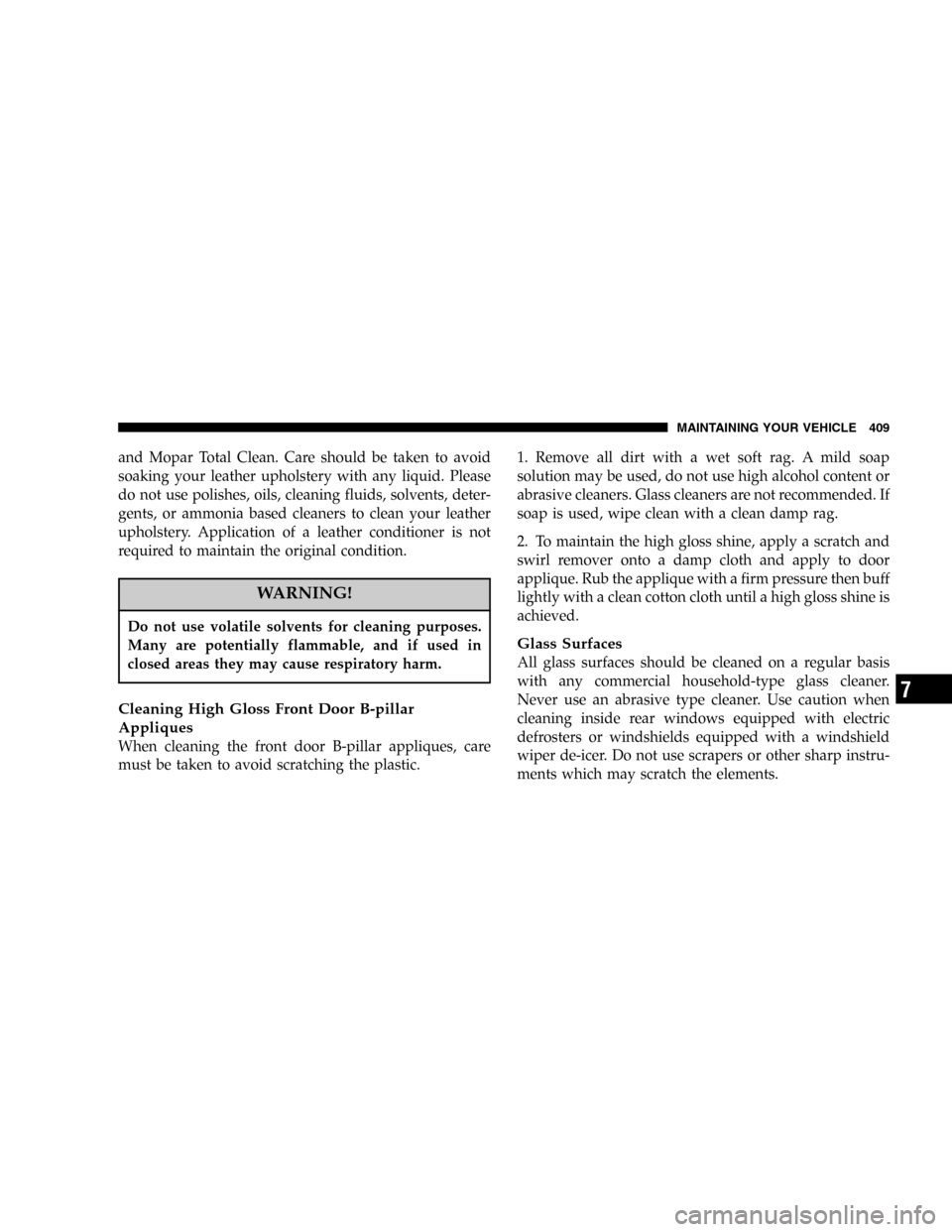2005 DODGE CARAVAN warning light
[x] Cancel search: warning lightPage 304 of 480

When the vehicle is driven over approximately 15 mph
(25 km/h), you may also hear a slight clicking sound as
well as some related motor noises. These noises are the
system performing its self check cycle to ensure that the
ABS system is working properly. This self check occurs
each time the vehicle is started and accelerated past
approximately 15 mph (25 km/h).
ABS is activated during braking under certain road or
stopping conditions. ABS-inducing conditions can in-
clude ice, snow, gravel, bumps, railroad tracks, loose
debris, or panic stops.
You also may experience the following when the brake
system goes into Anti-lock:
•The ABS motor running (it may continue to run for a
short time after the stop),
•the clicking sound of solenoid valves,
•brake pedal pulsations,
•and a slight drop or fall away of the brake pedal at the
end of the stop.
These are all normal characteristics of ABS.
WARNING!
The Anti-Lock Brake System contains sophisticated
electronic equipment that may be susceptible to
interference caused by improperly installed or high
output radio transmitting equipment. This interfer-
ence can cause possible loss of anti-lock braking
capability. Installation of such equipment should be
performed by qualified professionals.
304 STARTING AND OPERATING
Page 335 of 480

NOTE:
•Tighten the gas cap until you hear a“clicking”sound.
This is an indication that the gas cap is properly
tightened. If the gas cap is not secured properly the
Malfunction Indicator Light will turn on. Make sure
that the gas cap is tightened each time the vehicle is
refueled.
•When the fuel nozzle“clicks”or shuts off, the fuel
tank is full.
WARNING!
•Never have any smoking materials lit in or near
the vehicle when the gas cap is removed or the
tank filled.
•Never add fuel to the vehicle when the engine is
running.
•A fire may result if gasoline is pumped into a
portable container that is inside of a vehicle. You
could be burned. Always place gas containers on
the ground while filling.
STARTING AND OPERATING 335
5
Page 354 of 480

6. These locations are on the sill flange of the body and
consist of a pair of downstanding tabs. The jack is to be
located, engaging the flange, between the pair of tabs
closest to the wheel to be changed. Place the wrench on
the jack screw and turn to the right until the jack head is
properly engaged in the described location.Do not raise
the vehicle until you are sure the jack is securely
engaged.
7. Raise the vehicle by turning the jack screw to the right,
using the swivel wrench. Raise the vehicle only until the
tire just clears the surface and enough clearance is
obtained to install the spare tire. Minimum tire lift
provides maximum stability.WARNING!
Raising the vehicle higher than necessary can make
the vehicle less stable. It could slip off the jack and
hurt someone near it. Raise the vehicle only enough
to remove the tire.
8. Remove the wheel lug nuts, for vehicles with wheel
covers, remove the cover from the wheel by hand. Do not
pry the wheel cover off. Then pull the wheel off the hub.
9. Install the compact spare tire. Lightly tighten the lug
nuts. To avoid the risk of forcing the vehicle off the jack,
do not tighten the lug nuts fully until the vehicle has been
lowered.
NOTE:Do not install the wheel cover on the compact
spare.
Do not use a hammer or force to install the wheel covers.
354 WHAT TO DO IN EMERGENCIES
Page 363 of 480

5. These locations are on the sill flange of the body and
consist of a pair of downstanding tabs. The jack is to be
located, engaging the flange, between the pair of tabs
closest to the wheel to be changed. Place the wrench on
the jack screw and turn to the right until the jack head is
properly engaged in the described location.Do not raise
the vehicle until you are sure the jack is securely
engaged.
6. Raise the vehicle by turning the jack screw to the right,
using the swivel wrench. Raise the vehicle only until the
tire just clears the surface and enough clearance is
obtained to install the spare tire. Minimum tire lift
provides maximum stability.WARNING!
Raising the vehicle higher than necessary can make
the vehicle less stable. It could slip off the jack and
hurt someone near it. Raise the vehicle only enough
to remove the tire.
7. Remove the wheel lug nuts, for vehicles with wheel
covers, remove the cover from the wheel by hand. Do not
pry the wheel cover off. Then pull the wheel off the hub.
8. Install the spare wheel, for vehicles with wheel covers,
align the notch in the wheel cover with the valve stem on
the wheel. Install the cover on the wheel by hand only
and install the wheel lug nuts with the cone shaped end
of the nut toward the wheel. Lightly tighten the lug nuts.
To avoid the risk of forcing the vehicle off the jack, do not
tighten the lug nuts fully until the vehicle has been
lowered.
WHAT TO DO IN EMERGENCIES 363
6
Page 401 of 480

replaced immediately! Eventual deterioration of the hose
can take place resulting in a possibility of a burst failure.
WARNING!
Worn brake hoses can burst and cause brake failure.
You could have an accident. If you see any signs of
cracking, scuffing, or worn spots, have the brake
hoses replaced immediately.
Master Cylinder—ABS Brakes Brake Fluid Level
Check
The fluid level in the master cylinder should be checked
when performing underhood services, or immediately if
the brake system warning light indicates system failure.
Clean the top of the master cylinder area before removing
the cap. Add fluid to bring the level up to the top of the
“FULL”mark on the side of the master cylinder reservoir.Overfilling of fluid is not recommended because it may
cause leaking in the system.
Add enough fluid to bring the level up to the require-
ments described on the brake fluid reservoir. With disc
brakes, fluid level can be expected to fall as the brake
pads wear. However, low fluid level may be caused by a
leak and a checkup may be needed.
Use only manufacturers recommended brake fluid, refer
to Recommended Fluids, Lubricants and Genuine Parts
for correct fluid type.WARNING!
Use of brake fluid that may have a lower initial
boiling point or unidentified as to specification, may
result in sudden brake failure during hard pro-
longed braking. You could have an accident.
MAINTAINING YOUR VEHICLE 401
7
Page 409 of 480

and Mopar Total Clean. Care should be taken to avoid
soaking your leather upholstery with any liquid. Please
do not use polishes, oils, cleaning fluids, solvents, deter-
gents, or ammonia based cleaners to clean your leather
upholstery. Application of a leather conditioner is not
required to maintain the original condition.
WARNING!
Do not use volatile solvents for cleaning purposes.
Many are potentially flammable, and if used in
closed areas they may cause respiratory harm.
Cleaning High Gloss Front Door B-pillar
Appliques
When cleaning the front door B-pillar appliques, care
must be taken to avoid scratching the plastic.1. Remove all dirt with a wet soft rag. A mild soap
solution may be used, do not use high alcohol content or
abrasive cleaners. Glass cleaners are not recommended. If
soap is used, wipe clean with a clean damp rag.
2. To maintain the high gloss shine, apply a scratch and
swirl remover onto a damp cloth and apply to door
applique. Rub the applique with a firm pressure then buff
lightly with a clean cotton cloth until a high gloss shine is
achieved.
Glass Surfaces
All glass surfaces should be cleaned on a regular basis
with any commercial household-type glass cleaner.
Never use an abrasive type cleaner. Use caution when
cleaning inside rear windows equipped with electric
defrosters or windshields equipped with a windshield
wiper de-icer. Do not use scrapers or other sharp instru-
ments which may scratch the elements.
MAINTAINING YOUR VEHICLE 409
7
Page 458 of 480

Adding Fuel........................... 334
Adding Washer Fluid..................286,392
Additives, Fuel......................... 332
Adjustable Pedals....................... 146
Air Conditioner Maintenance............... 388
Air Conditioning.....................262,267
Air Conditioning Controls................. 262
Air Conditioning Filter.................284,389
Air Conditioning, Operating Tips............ 284
Air Conditioning, Rear Zone.............270,279
Air Conditioning Refrigerant............... 388
Air Conditioning System..........262,267,272,388
Air Conditioning System, Zone Control........ 263
Air Pressure, Tires....................... 317
Airbag................................ 53
Airbag Deployment....................... 65
Airbag Light...................57,58,68,84,199
Airbag Maintenance....................... 67
Airbag, Window......................... 54Alarm Light........................... 200
Alarm System........................... 27
Alignment and Balance................... 324
Alterations/Modifications, Vehicle............. 7
Antenna, Satellite Radio................... 257
Antifreeze (Engine Coolant)...........395,396,421
Disposal............................ 397
Anti-Lock Brake System (ABS).............. 303
Anti-Lock Warning Light.................. 199
Anti-Theft Security Alarm.................. 27
Appearance Care........................ 406
Arming Theft System...................... 27
Ashtray............................... 171
Auto Down Power Windows................ 40
Automatic Dimming Mirror................. 92
Automatic Door Locks...................19,20
Automatic Headlights.................... 136
Automatic Temperature Control............. 272
Automatic Transaxle...................... 297
458 INDEX
Page 459 of 480

Interlock System....................... 298
Reset Mode.......................... 299
Selection Of Lubricant................403,423
Shifting............................. 299
Special Additives...................... 405
Automatic Transmission................... 402
Adding Fluid......................... 404
Fluid and Filter Changes................. 405
Fluid Change......................... 405
Fluid Level Check...................... 404
Fluid Type........................403,423
Ball Joints............................. 390
Battery............................... 387
Gas Caution.......................... 387
Jump Starting......................... 365
Keyless Transmitter Replacement............ 26
Saving Feature (Protection)............... 137
Bearings.............................. 406Belts, Drive............................ 383
Body Mechanism Lubrication............... 391
B-Pillar Location........................ 312
Brake Fluid............................ 423
Brake, Parking.......................... 301
Brake System........................302,399
Anti-Lock........................... 303
Fluid Check.......................... 401
Hoses.............................. 400
Warning Light........................ 197
Brakes.............................302,399
Brake/Transmission Interlock............... 298
Break-In Recommendations, New Vehicle........ 82
Bulb Replacement....................... 416
Bulbs, Light............................ 415
Calibration, Compass..................... 152
Capacities, Fluid........................ 421
INDEX 459
10